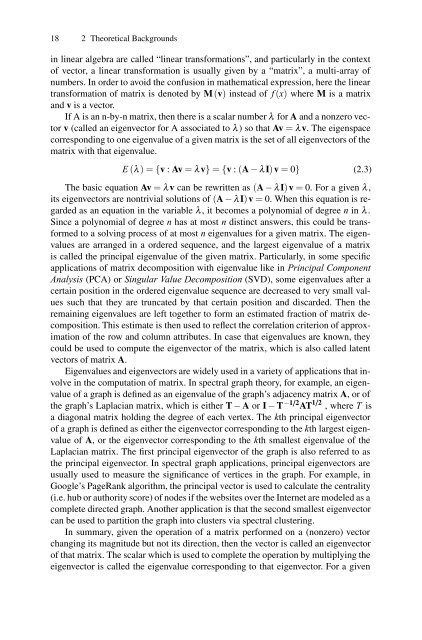Web Mining and Social Networking: Techniques and ... - tud.ttu.ee
Web Mining and Social Networking: Techniques and ... - tud.ttu.ee
Web Mining and Social Networking: Techniques and ... - tud.ttu.ee
- No tags were found...
You also want an ePaper? Increase the reach of your titles
YUMPU automatically turns print PDFs into web optimized ePapers that Google loves.
18 2 Theoretical Backgroundsin linear algebra are called “linear transformations”, <strong>and</strong> particularly in the contextof vector, a linear transformation is usually given by a “matrix”, a multi-array ofnumbers. In order to avoid the confusion in mathematical expression, here the lineartransformation of matrix is denoted by M(v) instead of f (x) where M is a matrix<strong>and</strong> v is a vector.If A is an n-by-n matrix, then there is a scalar number λ for A <strong>and</strong> a nonzero vectorv (called an eigenvector for A associated to λ ) so that Av = λ v. The eigenspacecorresponding to one eigenvalue of a given matrix is the set of all eigenvectors of thematrix with that eigenvalue.E (λ )={v : Av = λ v} = {v : (A − λ I)v = 0} (2.3)The basic equation Av = λ v can be rewritten as (A − λ I)v = 0. For a given λ ,its eigenvectors are nontrivial solutions of (A − λ I)v = 0. When this equation is regardedas an equation in the variable λ , it becomes a polynomial of degr<strong>ee</strong> n in λ .Since a polynomial of degr<strong>ee</strong> n has at most n distinct answers, this could be transformedto a solving process of at most n eigenvalues for a given matrix. The eigenvaluesare arranged in a ordered sequence, <strong>and</strong> the largest eigenvalue of a matrixis called the principal eigenvalue of the given matrix. Particularly, in some specificapplications of matrix decomposition with eigenvalue like in Principal ComponentAnalysis (PCA) or Singular Value Decomposition (SVD), some eigenvalues after acertain position in the ordered eigenvalue sequence are decreased to very small valuessuch that they are truncated by that certain position <strong>and</strong> discarded. Then theremaining eigenvalues are left together to form an estimated fraction of matrix decomposition.This estimate is then used to reflect the correlation criterion of approximationof the row <strong>and</strong> column attributes. In case that eigenvalues are known, theycould be used to compute the eigenvector of the matrix, which is also called latentvectors of matrix A.Eigenvalues <strong>and</strong> eigenvectors are widely used in a variety of applications that involvein the computation of matrix. In spectral graph theory, for example, an eigenvalueof a graph is defined as an eigenvalue of the graph’s adjacency matrix A,orofthe graph’s Laplacian matrix, which is either T − A or I − T −1 /2 AT 1 /2 , where T isa diagonal matrix holding the degr<strong>ee</strong> of each vertex. The kth principal eigenvectorof a graph is defined as either the eigenvector corresponding to the kth largest eigenvalueof A, or the eigenvector corresponding to the kth smallest eigenvalue of theLaplacian matrix. The first principal eigenvector of the graph is also referred to asthe principal eigenvector. In spectral graph applications, principal eigenvectors areusually used to measure the significance of vertices in the graph. For example, inGoogle’s PageRank algorithm, the principal vector is used to calculate the centrality(i.e. hub or authority score) of nodes if the websites over the Internet are modeled as acomplete directed graph. Another application is that the second smallest eigenvectorcan be used to partition the graph into clusters via spectral clustering.In summary, given the operation of a matrix performed on a (nonzero) vectorchanging its magni<strong>tud</strong>e but not its direction, then the vector is called an eigenvectorof that matrix. The scalar which is used to complete the operation by multiplying th<strong>ee</strong>igenvector is called the eigenvalue corresponding to that eigenvector. For a given




![[ ] rad - tud.ttu.ee](https://img.yumpu.com/51069910/1/184x260/-rad-tudttuee.jpg?quality=85)












